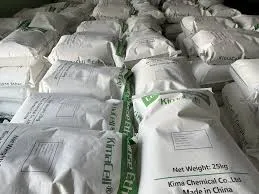
Lis . 18, 2024 09:44 Back to list
Applications of HPMC in Laundry Detergents and Household Cleaning Products
The Role of Hydroxypropyl Methylcellulose (HPMC) in Detergent Formulations
Hydroxypropyl Methylcellulose (HPMC) is a versatile and widely used polymer in various industries, including the detergent sector. Its unique properties make it an essential ingredient in formulating both household and industrial cleaning products. This article delves into the uses of HPMC in detergents, highlighting its benefits and functionalities.
The Role of Hydroxypropyl Methylcellulose (HPMC) in Detergent Formulations
Moreover, HPMC serves as a stabilizing agent. Many liquid detergents are susceptible to separation, which can affect performance and shelf life. By incorporating HPMC, manufacturers can stabilize the formulation, preventing the separation of ingredients and ensuring that the product remains homogeneous throughout its use. This stability is particularly important for multi-functional detergents that combine several cleaning properties in one product.
hpmc uses in detergent

In addition to thickening and stabilizing, HPMC also has excellent water retention capabilities. In powdered detergents, HPMC can help maintain moisture levels, preventing clumping and ensuring the granules remain free-flowing. This characteristic is vital for powders that need to dissolve quickly in water for effective cleaning. HPMC enhances the dissolution rate of detergent powders, ensuring that active cleaning agents are readily available when the product is used.
Another significant advantage of using HPMC in detergents is its biodegradability. As consumers become increasingly conscious of environmental sustainability, the demand for eco-friendly cleaning products is on the rise. HPMC is derived from natural cellulose and is biodegradable, making it an attractive option for environmentally conscious formulations. By choosing HPMC, detergent manufacturers can align their products with the sustainability goals of consumers, ultimately boosting market appeal.
Furthermore, HPMC can enhance the performance of surfactants in detergent formulations. Surfactants are critical components responsible for breaking down grease and dirt. When HPMC is used in conjunction with surfactants, it can improve foaming and emulsification properties, which are essential for achieving effective cleaning outcomes. The combination of HPMC and surfactants creates a synergistic effect that enhances cleaning power, enhancing the overall efficacy of the detergent.
In conclusion, Hydroxypropyl Methylcellulose plays a multifaceted role in detergent formulations, contributing to thickening, stabilization, moisture retention, and performance enhancement. Its biodegradability further positions it as a desirable ingredient in eco-friendly products. As the detergent industry continues to evolve, the incorporation of versatile ingredients like HPMC will be pivotal in meeting consumer demands for effective and sustainable cleaning solutions.
-
Unlocking the Benefits of HPMC Products: A Gateway to Versatile Applications
NewsAug.07,2025
-
Unleashing the Potential of HPMC Ashland: A Comprehensive Look
NewsAug.07,2025
-
Tile Bonding Cellulose: The Key to Superior Adhesion and Durability
NewsAug.07,2025
-
Hydroxypropyl Methylcellulose Powder: The Versatile Component in Modern Pharmaceuticals
NewsAug.07,2025
-
Hydroxyethyl Cellulose: The Versatile Solution for Various Industries
NewsAug.07,2025
-
Hydroxyethyl Cellulose (HEC): The Versatile Polymer for Various Applications
NewsAug.07,2025







